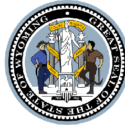Wyoming was a Republican territory in the 1880s, but both Democrats and Republicans agreed that they wanted to become a state. Statehood would give the territory’s leaders more control over land and water issues that were causing concern for businesses and politicians alike.
But by 1888, Wyoming still had only 55,000 of the required 60,000 people. That was the minimum for statehood, and Wyoming just didn’t have the numbers. Its petitions for statehood kept getting turned down for just this reason.
Other states, such as Arkansas, slipped in with fewer people than 60,000. Wyoming is a big state, though, and it was a big territory. The population was scattered and it was hard to overlook the small numbers.
Wyoming went ahead and called a constitutional convention for 1889. After lots of debate, the state constitution passed with 6,272 votes in favor and 1,903 against. The Territorial Delegate to Congress, Joseph M. Carey, introduced a statehood bill and started claiming that Wyoming actually had 125,000 residents. There was some discussion on the voter numbers for the constitution, but it wasn’t a worry about voter turnout — it was concern that the population might not really be as large as Carey said.
Carey pointed out that there had been seven territories already admitted with fewer than the required number of residents. All of them had doubled their populations within the first five years of statehood. Territories, he said, always became more prosperous and successful as states.
Democrats in Congress
Once Congress decided to overlook the population question, other objections began to pop up from Democrats in Congress. Republicans were the majority, and Wyoming was a Republican territory. It still is a Republican state. Wyoming was much closer to offering women equal rights than any other state. Women had the vote in Wyoming Territory decades before the nation got on board with woman suffrage. The Democratic party wasn’t particularly opposed to women’s rights, but they knew they couldn’t just say, “We don’t want any more Republicans in Congress.”
They argued about women’s rights instead.
Their ploy was not successful. Congress narrowly voted Wyoming in, 139-127. It took the Senate three months to pass the bill, and President Benjamin Harrison signed it. Wyoming became a state in 1890.
Lessons for Puerto Rico
In the 1890 census, Wyoming turned up with an official population of 62,555. Carey was definitely fudging the facts in 1889.
It has continued to be one of the least populous states in the Union. With just 579,315 residents, it’s much smaller than Puerto Rico. Population will not be an issue in discussions of Puerto Rico statehood.
Puerto Rico is not a Republican territory, nor a Democratic one. Governor Rossello has predicted that it will be a “battleground” state — one of those that can’t be predicted easily. Statehood for Puerto Rico is a bipartisan issue in the United States. Even so, there could be concerns in Congress about the party allegiance of Puerto Rico. If so, these concerns will probably be masked, just as they were for Wyoming. We don’t yet know what issues will come up in Congressional debates about Puerto Rico statehood. Still, the experience of Wyoming shows that contentious issues can be overcome.
Tell your congressional reps that you support statehood.








One response
I pray to God that the United States of America once and for all will grant the U. S. Citizens of Puerto Rico statehood.